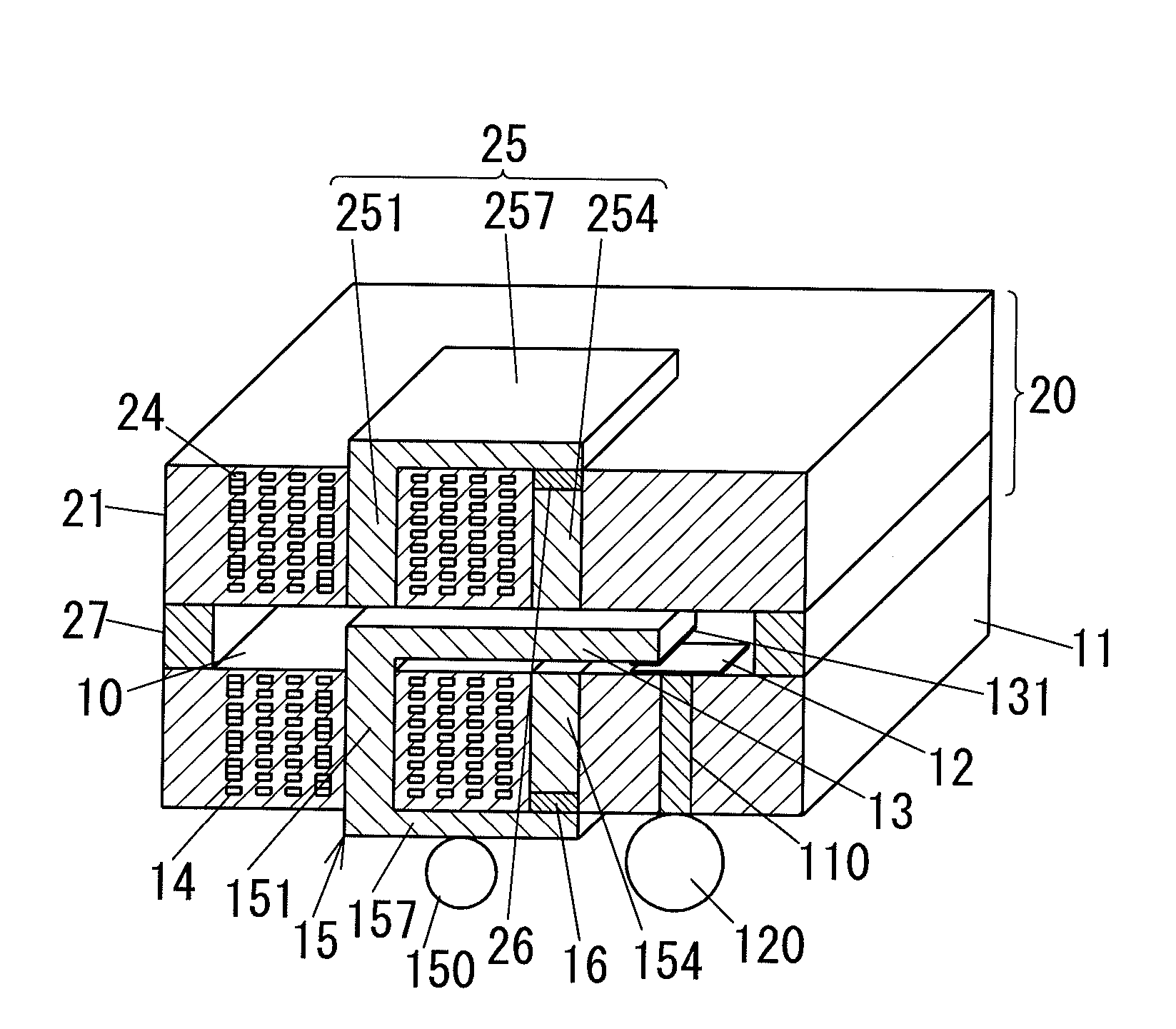Micro relay
a micro-relay and relay technology, applied in the field of micro-relay, can solve the problems of difficult to obtain sufficient ampere turns, and achieve the effect of reducing the leakage of high-frequency signals
- Summary
- Abstract
- Description
- Claims
- Application Information
AI Technical Summary
Benefits of technology
Problems solved by technology
Method used
Image
Examples
first embodiment
[0039]FIG. 1 shows a micro relay in accordance with a first embodiment of the present invention. This micro relay includes a main substrate 11, a stationary contact 12, an armature 13, a coil 14, a magnetic member 15 and a permanent magnet 16, which together constitute a body of the micro relay.
[0040]The main substrate 11 has a plurality of laminated layers (not shown). For example, the main substrate 11 is a low temperature co-fired ceramics (LTCC) that is formed of a plurality of laminated ceramics sheets and includes the coil 14. The main substrate 11 further includes a conductive part (e.g., conductive paste coated through hole) 110 formed of a through hole and conductive material, as well as first and second through holes 111 and 112 in which a part of the magnetic member 15, namely a core 151 and a first yoke 154 are located, respectively. The second through hole 112 is located between the first through hole 111 and the conductive part 110. In an example, the conductive part 1...
second embodiment
[0053]FIG. 4 shows a micro relay in accordance with a second embodiment of the present invention. For the purpose of clarity, like kind elements are assigned the same reference numerals as depicted in the first embodiment. In place of the cover 2 of the first embodiment, the micro relay in the second embodiment includes a cover 2 formed of a second substrate 21, a coil 24, a magnetic member 25, a permanent magnet 26 and a spacer 27.
[0054]In the second embodiment, the second substrate 21 is a laminated substrate (e.g., LTCC) like the main substrate 11 of the first embodiment. The coil 24 is formed of a plurality of (nine in FIG. 4) planer coils connected in series like the coil 14 of the first embodiment.
[0055]The magnetic member 25 has a core 251, a first yoke 254 and a second yoke 257. Each of the core 251, first yoke 254 and second yoke 257 is a flat piece of a magnetic substance. First and second ends of the core 251 are flush with one side (an upper surface) and the other (a low...
third embodiment
[0060]FIG. 7 shows a micro relay in accordance with a third embodiment of the present invention. For the purpose of clarity, like kind elements are assigned the same reference numerals as depicted in the first embodiment.
[0061]In the first embodiment, the permanent magnet 16 (magnetic substance) is formed of well known material having large coercive force in and above the cavity by a deposition method such as an aerosol deposition method, a pulsed laser deposition method, a plating method, a screen print method or the like. However, the magnet 16 comes to have a comparatively small magnetic force, and accordingly the magnet 16 needs to be made larger, so that the permanent magnet occupies larger part in the above-mentioned closed magnetic path. Because of this, the number of turns of the coil is increased and the size of the micro relay is increased.
[0062]If the permanent magnet 16 is a sintered magnet, the sintered magnet has a comparatively large magnetic force and therefore the m...
PUM
 Login to View More
Login to View More Abstract
Description
Claims
Application Information
 Login to View More
Login to View More - R&D
- Intellectual Property
- Life Sciences
- Materials
- Tech Scout
- Unparalleled Data Quality
- Higher Quality Content
- 60% Fewer Hallucinations
Browse by: Latest US Patents, China's latest patents, Technical Efficacy Thesaurus, Application Domain, Technology Topic, Popular Technical Reports.
© 2025 PatSnap. All rights reserved.Legal|Privacy policy|Modern Slavery Act Transparency Statement|Sitemap|About US| Contact US: help@patsnap.com



